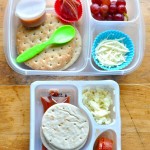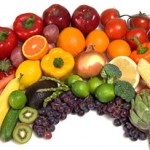All children need a balanced diet to allow their bodies and minds to develop; those with celiac disease or gluten sensitivity are especially at risk of nutritional and vitamin deficiencies. Get Back to the Basics for Back to School with these tips to ensure your child has the best chance at learning and growing this year:
 Start the day off right with a nutritious breakfast to increase concentration throughout the day. Whole foods (for example, an apple rather than apple juice, or whole grain gluten-free bread rather than white bread) are digested more slowly and provide longer lasting energy for your child. Hectic household in the mornings? Blend together this power smoothie and grab a delicious Nature Valley Roasted Nut Crunch bar for the car ride to school.
Start the day off right with a nutritious breakfast to increase concentration throughout the day. Whole foods (for example, an apple rather than apple juice, or whole grain gluten-free bread rather than white bread) are digested more slowly and provide longer lasting energy for your child. Hectic household in the mornings? Blend together this power smoothie and grab a delicious Nature Valley Roasted Nut Crunch bar for the car ride to school.
 Recreate lunches that your child might see his or her friends having at the lunch tables. Pack a divided container with gluten-free crackers and slices of deli meat and cheese (or dairy-free cheese substitute). Make mini pizzas from a gluten-free English muffin with pizza sauce, shredded cheese, and turkey pepperoni.
Recreate lunches that your child might see his or her friends having at the lunch tables. Pack a divided container with gluten-free crackers and slices of deli meat and cheese (or dairy-free cheese substitute). Make mini pizzas from a gluten-free English muffin with pizza sauce, shredded cheese, and turkey pepperoni.
 Sneak in nutrition if you have a picky eater…blend carrots and spinach into pizza or marinara sauce; add a tablespoon of ground flaxseed to your child’s morning smoothie; bake these black bean brownies for a treat that will make both you and them smile.
Sneak in nutrition if you have a picky eater…blend carrots and spinach into pizza or marinara sauce; add a tablespoon of ground flaxseed to your child’s morning smoothie; bake these black bean brownies for a treat that will make both you and them smile.
 Make a game of it: see if your family can eat one fruit or vegetable from every color of the rainbow to ensure you’re all getting the important vitamins and minerals that are often absent from gluten-free snack foods. Your goal can be to eat the entire rainbow either every day or every week, depending on how many servings of fruits and veggies your family currently eats. Use colored stickers on your family calendar to keep track of every color food that you eat each day. A sample day of eating the rainbow could look like this:
Make a game of it: see if your family can eat one fruit or vegetable from every color of the rainbow to ensure you’re all getting the important vitamins and minerals that are often absent from gluten-free snack foods. Your goal can be to eat the entire rainbow either every day or every week, depending on how many servings of fruits and veggies your family currently eats. Use colored stickers on your family calendar to keep track of every color food that you eat each day. A sample day of eating the rainbow could look like this:
Oranges at breakfast
Green apples at snack
Yellow squash sticks dipped in ranch dressing with lunch
Blueberries with after-school snack
Tomatoes or tomato sauce at dinner
Communicate with your school about your child’s needs. Obtain their 504 form, or provide CDF’s sample form available here. Sit down with your child’s teacher, school nurse, counselor, and/or administrators, and offer educational and awareness resources from CDF. Explain what specifically happens to your child when he/she eats gluten, and ask them to notify you of classroom parties and field trips so you and your child can be prepared.